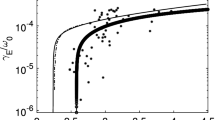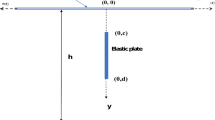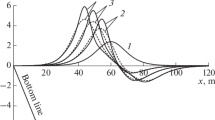Abstract
Freely propagating surface gravity waves are observed to slow down and to stop at a beach when the bottom has a relatively gentle upward slope toward the shore and the frequency range of the waves covers the most energetic wind waves (sea and swell). Essentially no wave reflection can be seen and the measured reflected energy is very small compared to that transmitted shoreward. One consequence of this is that the flux of the wave’s linear momentum decreases in the direction of wave propagation, which is equivalent to a time rate of change of the momentum. It takes a force to cause the time rate of change of the momentum. Therefore, the bottom exerts a force on the waves in order to decrease the momentum flux. By Newton’s third law (action equals reaction) the waves then impart an equal but opposite force to the bottom. In shallow (but finite) water depths the wave force per unit bottom area is calculated, for normal angle of incidence to the beach, to be directly proportional to the square of the wave amplitude and to the bottom slope and inversely proportional to the mean depth; it is independent of the wave frequency. Constants of proportionality are: 1/4, the fluid density and the acceleration of gravity. Swell attenuation near coasts and some characteristics of sand movement in the near-shore region are not inconsistent with the algebraic structure of the wave force formula. Since the force has a depth variation which is significantly faster than that of the dimensions of the particle orbits in the vertical direction, the bottom induces a torque on the fluid particles that decreases the angular momentum flux of the waves. By an extension of Newton’s third law, the waves also exert an equal but opposite torque on the bottom. And because the bottom force on the waves exists over a horizontal distance, it does work on the waves and decreases their energy flux. Thus, theoretically, the fluxes of energy, angular and linear momentum are not conserved for shoaling surface gravity waves. Mass flux, associated with the Stokes drift, is assumed to be conserved, and the wave frequency is constant for a steady medium.
Similar content being viewed by others
References
Ardhuin, F., W. C. O’Reilly, T. H. C. Herbers and P. F. Jessen (2003): Swell transformation across the continental shelf. Part I: Attenuation and directional broadening. J. Phys. Oceanogr., 33, 1921–1939.
Barnett, T. P. and K. E. Kenyon (1975): Recent advances in the study of wind waves. Rep. Prog. Phys., 38, 667–729.
Boccotti, P. (2000): Wave Mechanics for Ocean Engineering. Elsevier, New York, 495 pp.
Einstein, A. (1916): Elementare Theorie der Wasserwellen und des Fluges. Naturwissenschaften, 24, 509–510.
Elgar, S., T. H. C. Herbers and R. T. Guza (1994): Reflection of ocean surface gravity waves from a natural beach. J. Phys. Oceanogr., 24, 1653–1658.
Ference, M., Jr., H. B. Lemon and R. J. Stepheson (1956): Analytical Experimental Physics. 2nd ed., The University of Chicago Press, 623 pp., p. 98.
Hasselmann, K., T. P. Barnett, E. Bouws, H. Carlson, D. E. Cartwright, K. Enke, J. A. Ewing, H. Gienapp, D. E. Hasselmann, P. Kruseman, A. Meerburg, P. Muller, D. J. Olbers, K. Richter, W. Sell and H. Walden (1973): Measurements of wind-wave growth and swell decay during the Joint North Sea Wave Project (JONSWAP). Deutsches Hydrographisches Instut, Hamburg.
Ippen, A. T. (1966): Estuary and Coastline Hydrodynamics. McGraw-Hill, New York, 744 pp., p. 63.
Kenyon, K. E. (2004): Force and torque on a wall from reflected surface gravity waves. Phys. Essays, 17 (in press).
Kenyon, K. E. and D. Sheres (1991): Stable gravity wave of arbitrary amplitude in finite depth. Int. J. Theor. Phys., 29, 101–108.
Kenyon, K. E. and D. Sheres (1996): Angular momentum and action in surface gravity waves: application to wave-current interaction. J. Geophys. Res., 101, 1247–1252.
Komar, P. D. (1998): Beach Processes and Sedimentation. 2nd ed., Prentice Hall, New Jersey, 544 pp., p. 276–290.
Lamb, H. (1932): Hydrodynamics. 6th ed., Dover, New York, 738 pp., p. 367.
Munk, W. H., G. R. Miller, F. E. Snodgrass and N. F. Barber (1963): Directional recording of swell from distant storms. Proc. Roy. Soc., A, 255, 505–584.
Phillips, O. M. (1966): The Dynamics of the Upper Ocean. 1st ed., Cambridge Univ. Press, 261 pp., p. 55.
Rundgren, L. (1958): Trans. Roy. Inst. Tech. No. 122, Stockholm, Sweden.
Shepard, F. P. (1959): The Earth beneath the Sea. The Johns Hopkins Press, MD, 275 pp., p. 20.
Stokes, G. G. (1847): Trans. Camb. Phil. Soc., 8, 441–455.
Author information
Authors and Affiliations
Rights and permissions
About this article
Cite this article
Kenyon, K.E. Shoaling Surface Gravity Waves Cause a Force and a Torque on the Bottom. J Oceanogr 60, 1045–1052 (2004). https://doi.org/10.1007/s10872-005-0012-8
Received:
Revised:
Accepted:
Issue Date:
DOI: https://doi.org/10.1007/s10872-005-0012-8




